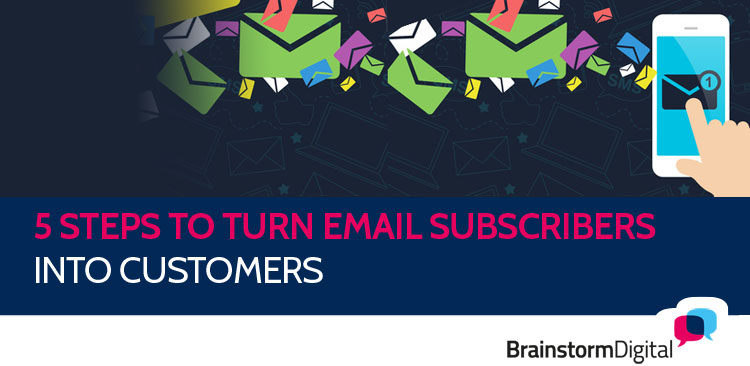We were really thrilled to have such a great response to our webinar, 5 Steps to Turn Email Subscribers Into Customers. You can watch a replay here!
Unfortunately we didn’t get a chance to answer everyone’s questions live, so we’re going to answer them here instead.
We hope you find them useful – and if you have any more questions about email marketing and email automation, please do leave a comment, and we’ll be sure to get back to you.If I want to start email marketing seriously, which platform should I use?
1. If I want to start email marketing seriously, which platform should I use?
There are dozens if not hundreds of email marketing systems out there, which usually have similar basic functionality, and are much of a muchness. Where they tend to differ is in their user interface – ie., some are more user-friendly than others – and in their more sophisticated functions.
So, you need to do your research, and seek demos and user-reviews before committing to any system, because it can be annoying to switch.
Two of the most popular systems are MailChimp and CampaignMonitor.
They both allow you to segment your audience and set up automation, while offering different templates, A/B testing so that you can see what works best for individual emails, and analytics that crunch the numbers for you – so great, basic systems.
Having used both, my personal preference is for CampaignMonitor. I find it much more intuitive to use and its post-campaign reports much clearer.
I also find it better once your email marketing has become a bit more sophisticated, and you’ve segmented your list. If you decide to email several of your segments simultaneously, and the same email address appears on two lists, MailChimp will email it twice – which can be enormously annoying for the recipient.
However, MailChimp has a much larger market share, so obviously not everyone agrees with me!
If you’re just starting out, MailChimp will be cheaper, as it’s free for up to 2,000 subscribers / 12,000 emails a month, while CampaignMonitorcharges $9/month for up to 12,000 emails. After that, both increase incrementally, so you’ll have to work out carefully what might be best long-term.
More sophisticated systems like InfusionSoft, Hubspot and Marketo are in a completely different league, because they integrate your email marketing with the rest of your online activities. They help you keep track of all your interactions with your contacts (basically acting as a CRM), can tell you which are your keenest prospects, trigger personalised messages depending on what your contacts do on email and on your website – and more.
Their British equivalent is CommsBox, which we showed you a little bit of during the webinar. If you’re in the UK, not only does it allow you to create highly personalised campaigns for your users, you have the advantage of local support, and a team that can customise the software for your needs, if necessary.
These big beasts are worth every penny once you have a decent-sized email list, or if you are serious about creating one.
2. How do I build up an email list if, at the moment, I hardly have any subscribers?
Building up your email list should be a priority even if you have thousands of subscribers.
First of all, an email list is one of your company’s greatest assets. Think of it as a database of potential clients. But unlike your social media fans and followers, that list actually belongs to you!
Second of all, there is natural attrition even on a good, large list. There will always be unsubscribes – they’re unavoidable – people’s addresses change, and so on. You need to make up for this fall, as well as increase your pool of prospects.
So how do you do it?
- The simplest way is to give away a piece of terrific content, preferably for free, in exchange for someone’s email address. These pieces of content – which are called ‘lead magnets’ – are designed to attract the kind of people you want on your list. They could be an ebook, cheat sheet, swipe file, checklist, video, tool, or any other useful format. Read more about what makes a good lead magnet here. Post links to these lead magnets throughout your website, on your social media networks, and build up the audiences for those platforms. Best of all – advertise your lead magnets on social media. Yes, that’s right: Spend money promoting them, to a carefully chosen audience. If it helps you attract realistic prospects, that’s money well spent.
- If you’re just starting out, create a list of your current contacts, as well as your LinkedIn contacts. However, do not start sending them regular, mass emails without their permission – that will just annoy them, and create ‘Spam’ complaints and bad feeling for you. Instead, email them once, tell them about all the wonderful content you’re planning to share, and ask them to opt-in to your list. Only add those who agree to your database.
- One of the fastest ways to grow your email list is to work with partners who already have an email list. Find someone who might have the kind of subscribers you’re looking for – not a direct competitor, but someone in a related niche. Create a joint resource or event with them, such as an eBook or a webinar, promote it jointly, and then swap leads at the end. This usually works best when you already have some sort of email list, so that the other party benefits as well, but if you don’t, think carefully about what else you can give them that will make the joint venture worthwhile for them too.
- If you are selling directly online, make sure that any new customers tick a box opting into email communications. Again, this works best if you’re not just telling them they’ll receive a newsletter – that doesn’t sound very attractive if you’re a consumer! – but if you make clear the value they’ll receive from hearing from you.
Ensure that your emails are terrific! You’ll be surprised at how often your subscribers will forward emails to colleagues and friends, if they think they’ll be of interest. Your email could include a ‘subscribe’ button, to capture those leads.
3. Proper email marketing – segmenting your audience, sending out regular content – sounds enormously time-consuming and complicated. Where do we start and how do we keep things simple?
You’re right. Like all marketing, email marketing done ‘right’ does take time and work. The good news is that it’s worth it, and that it doesn’t have to be overwhelming.
I’d start by drawing up a simple strategy, so that your efforts are strategic and targeted, saving you time in the long-run. Think carefully about who your audience is, how you can reach them, and what you want to say to them. Draw up a basic schedule, so you know ahead of time when you’re going to send out your broadcast emails, and are not panicking because you have nothing to say on a given day!
Make sure that someone within your company is responsible for email marketing – you do not want this to be a ‘Who’s going to do this today’ kind of job – and that they receive all the training they need, both using the email marketing platforms, and understanding what kind of content they are expected to produce.
Then, it’s okay to go slow. You don’t have to start by emailing your entire list every day if that’s going to be too much. Once a week is okay. You don’t need to communicate with six different segments; segment your audience a few months down the line, when you’re more comfortable with your email marketing, or start with two. Similarly, don’t worry about creating five different lead-magnets. Start with one, and see how you go.
Remember, automation is your friend. You will be creating a lot of emails and content initially that will be in action for months and years to come. You also don’t have to create all your text completely from scratch. If you have great content that already exists, why not repurpose it?
As your company’s experience increases, so will your confidence, and you’ll be able to do more. But remember, plenty of companies get outside support from agencies, and that can be extremely helpful too.
4. How do I know how to segment my audience, and how many segments do I need?
As we explained in the webinar, there are different ways to segment your audience: By their interests, by their demographics, and by their behaviour.
How you do this depends very much on the nature of your business. Think about your existing customers (or your target audience – they don’t always overlap!): How do their buying patterns differ? Do you see men and women behaving differently? Does it depend on job titles or industry? Are people in different parts of the country perhaps interested in different services?
And how many different products and services do you have? If you offer, for example, two radically different services, it might make sense to divide your audience that way.
Ultimately, the number of segments you create will depend on both these factors, as well as how many you can handle. There’s no point creating six segments, if you don’t have the resources to email them all adequately.
5. If I’m emailing people every week – or more – how do I find new things to say to them?
If you have a very clear idea of who you’re trying to reach, coming up with original material becomes much easier. The biggest mistake you can make is to constantly write about your own company, your own products and services and internal developments. You need to maintain a clear focus on what interests your audience.
After you’ve segmented your audience, we recommend that you build personas, or fictional representations of your ideal clients (you can read about personas here). Outline everything you know about them – what their problems are, what they’re hoping to achieve with your product or service, what their concerns are about working with you….
Then start imagining: What would these people want to hear from you? What helpful tips can you give them? Whatever you create, refer back to the personas to ensure that it’s relevant to them, and also for inspiration during a dry spell.
Here are three shortcuts to developing a great list of email topics (these work well for blog posts, too).
- Write down your clients’ top 50 problems, then offer them your best insight and advice.
- Write down the top 50 mistakes they make, and then, again, help them correct them.
- Write down the top 50 questions you get asked by clients, and answer them.
See whether any themes emerge, or whether you can break down any issues into several components. If you can create a few ‘series’ of emails, that’s always useful.
Use your ideas to create an email marketing schedule, so that you are never scrambling for material last-minute. You could plan ahead 3 months, or even 6 or 12 months.
Any other questions about email marketing? Tell us in the comments!







